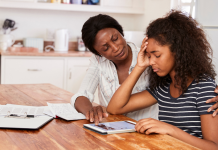May is Osteoporosis Awareness and Prevention Month! Bone health isn’t typically a major topic of conversation with my friends and me, but it really should be . . .
Osteoporosis affects more women than men, especially those who are past menopause as estrogen helps protect bone density. The Centers for Disease Control & Prevention (CDC) explain that women aged 50 and over have a quadrupled risk compared to men with the same age of developing osteoporosis of the femur, neck, or lumbar spine, and one out of two women over 50 will have an osteoporosis-related fracture in their lifetime.
Even if you’re a ways away from turning 50, there’s a lot we all can do now to make sure our bones are strong and healthy. It’s also important to know that if you’re over 50 or past menopause already, it’s not too late to modify what you can to prevent a broken bone!
 What Is Osteoporosis?
What Is Osteoporosis?
Osteoporosis is a disease in which your bone density is weakened, which puts you at risk for a broken bone or fracture. There are not many symptoms associated, so it is typically caught through screening tests, which include testing, and a discussion of your family history and lifestyle habits (diet, exercise, etc).
Broken bones can cause significant setbacks in your physical and mental health later in life, as your bones may take longer to heal and may cause more long-term problems.
Am I at Risk for Osteoporosis?
This is a conversation for you to have with your doctor at your annual visit, but here are some risk factors for developing osteoporosis:
- Family history of osteoporosis
- Menopause, or no menstrual period in the past three months
- Are white
- Smoking habit
- Don’t get enough physical activity or calcium and vitamin D
- Consume excess alcohol
- Have some chronic conditions, such as diabetes, inflammatory bowel disease, and depression (among others)
What Can I Do to Help Prevent Osteoporosis Now?
Luckily, many of the actions we can take to prevent osteoporosis are the backbone of living a healthy life! The benefits of these lifestyle changes are far-reaching beyond preventing osteoporosis, and they are attainable for everyone.

Calcium and Vitamin D
Calcium is an important mineral for bone, muscle, heart, and nerve health. It’s recommended by the National Institutes of Health (NIH) that women aged 19-50 years old get at least 1,000 mg of calcium per day, and women over 50 years old get at least 1,200 mg per day. Calcium is most commonly found in dairy, like milk (300 mg in one cup), yogurt (450 mg in one cup), and cheese (200 mg in one ounce of mozzarella cheese). It is also found in salmon (170 mg in three ounces), leafy green vegetables like spinach (240 mg in one cup of cooked spinach), and can be in some food fortified with calcium like tofu, cereal, juice, and oatmeal.
Vitamin D is also essential to help our bodies absorb calcium, as well as maintain strong muscles and an immune system. NIH recommends 15 mcg (600 IU) daily and 20 mcg (800 IU) for those over 70 years old. Vitamin D is not very readily available in foods but is mostly in fortified foods (milk, yogurt, cereals, orange juice). Some vitamin D can be absorbed from the sun, but overall, many Americans have low vitamin D and may benefit from a supplement.
Minimize Exposure to Toxic Substances
Even though it’s so common, alcohol can be considered toxic to the body. Smoking can also affect your bone health, so it’s recommended to make healthy lifestyle choices to limit alcohol intake and quit smoking.
Exercise Frequently
The benefits of exercise have been so well-known for physical and mental health, plus exercise is a great way to get the whole family active together. It’s recommended to have 150 minutes of moderate-intensity exercise per week.
- Weight-bearing exercises (those that involve your bones supporting the weight of your body) are great to do daily, such as brisk walking (three to four miles per hour), jogging or running, dancing, or racket sports (pickleball, tennis, etc). This could be a good “excuse” to try the latest rage of pickleball in the Lowcountry! Even if step count isn’t your goal, you can incorporate more walking into your daily routine by taking short breaks at work, choosing to walk instead of drive if it’s a short distance, or focusing the family on an evening walk together.
- Resistance training or weight lifting is probably the most well-known to help with preventing osteoporosis. It’s recommended adults do this type of exercise at least twice a week at moderate intensity. Though it may sound intimidating to those who need a map to get through a commercial gym, weight lifting can look like using dumbbells or resistance bands or even using your own body weight (push-ups, pull-ups, body weight squats) or my favorite method: using your young child as a weight!
As a Crossfitter, I often hear the excuse, “I don’t want to lift all those heavy weights because I’ll get bulky.” What many people don’t realize is that to get a “bulky” physique, women have to do way more than lift heavy weights. I’ve been encouraged by somewhat of a shift in gym culture lately to focus on how strong we are and how we feel, as opposed to how our physique looks — so being strong is sexy!
- Balance training is often the most forgotten form of exercise. This can be incorporated into either of the two previous types of exercise. Can you add in some single-leg lunges or walking backward into your workout? While you’re waiting for your kids to finish up sports practice, can you do some single-leg step-ups on the stadium stairs?
Hopefully, you’ve learned a little more about osteoporosis and how to prevent it! It’s never too late to change your diet or lifestyle to prioritize your bone health. The benefits of those changes go beyond just your bones!













